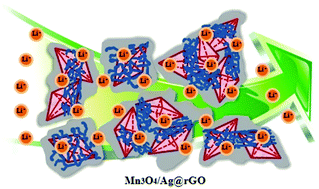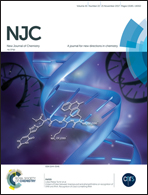Facile fabrication of graphene-encapsulated Mn3O4 octahedra cross-linked with a silver network as a high-capacity anode material for lithium ion batteries†
Abstract
A graphene-encapsulated Mn3O4/Ag nanocomposite is fabricated through a simple dealloying method to obtain Mn3O4 octahedra embedded in a nanoporous Ag network followed by encapsulation by graphene nanosheets. Upon selectively dissolving the Al atoms from the MnAgAl alloy, the residual Ag atoms assemble to form a well-conductive network; meanwhile the Mn atoms undergo natural oxidation to form Mn3O4 octahedra that travel through the Ag network. The positively charged Mn3O4/Ag composite modified by aminopropyltrimethoxysilane was enwrapped by negatively charged graphene oxide nanosheets followed by a reduction process. Owing to the combination of Mn3O4/Ag well-encapsulated in graphene nanosheets, the as-made composite exhibited significantly enhanced lithium storage performances with much higher reversible capacity and superior cycling stability as compared with the pure Mn3O4 and Mn3O4@rGO. In particular, the Mn3O4/Ag@rGO composite shows high reversible capacity retention of 971.5 and 763.5 mA h g−1 at 300 and 1000 mA g−1 over 200 cycles, respectively. In addition, it shows excellent rate capability even when continuously cycled at high current densities of 1000, 2000, and 3000 mA g−1. With the advantages of excellent performance and facile preparation, the as-made Mn3O4/Ag@rGO composite shows promising application potential as an anode material in lithium ion batteries.



 Please wait while we load your content...
Please wait while we load your content...